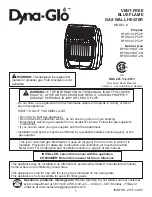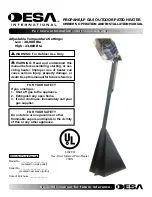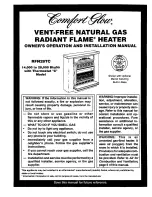
Page 14
For all appliances:
• The heater, when installed, must be electrically grounded in accordance with local codes or, in the
absence of local codes, with the National Electrical Code, ANSI/NFPA 70, or the
Canadian Electrical Code, CSA C22.1.
• Certain materials or items, when stored under the heater, will be subjected to radiant heat and could
be seriously damaged.
• Inspect the visible portion of the hose before each use of the appliance. Hose inside cylinder pole
housing should be checked annually and a leak test should be performed when re-assembled.
• Children and adults should be alerted to the hazards of high surface temperatures and should stay
away to avoid burns or clothing ignition.
• Young children should be carefully supervised when they are in the area of the heater.
• Clothing or other flammable materials should not be hung from the heater, or placed on or near the
heater.
• Any guard or other protective device removed for servicing the heater must be replaced prior to
operating the heater.
• Installation and repair should be done by a qualified service person. The heater should be inspected
before use and at least annually by a qualified service person.
More frequent cleaning may be required as necessary. It is imperative that control compartment,
burners and circulating air passageways of the heater be kept clean.
• Keep the appliance area clear and free from combustible materials, gasoline and other flammable
vapors and liquids.
• Do not obstruct the flow of combustion and ventilation air.
• Keep the ventilation opening of the cylinder enclosure free and clear from debris.
An appliance may be installed with shelter no more inclusive than:
a. With walls on all sides, but with no overhead cover.
b. Within a partial enclosure which includes an overhead cover and no more than two side walls. These
side walls may be parallel, as in a breezeway, or right angles to each other.
c. Within a partial enclosure which includes an overhead cover and three side walls, as long as 30
percent or more of the horizontal periphery of the enclosure is permanently open.
The LP-gas supply cylinder to be used must be:
a. Constructed and marked in accordance with the specifications for LP-gas cylinders of the
U.S. Department of Transportation (DOT); or the Standard for cylinders, Spheres and Tubes for
Transportation of Dangerous Goods and Commission, CAN/CSA-B339, as applicable;
b. Provided with a listed overfilling prevention device; and
c. Provided with a cylinder connection device compatible with the connection for the appliance.
d. 20LB (9kg) cylinder. LPG capacity 4.7 gallons (17.8 litres) Cylinder Dimensions: Height 17.75 inches
(451mm) and width 12.25 inches (311mm)
e. The LP - gas cylinder used must include a collar to protect the cylinder valve.
A cylinder must be stored outdoors in a well-ventilated area out of reach of children. A disconnected
cylinder must have dust caps tightly installed and must not be stored in a building, garage or any
enclosed area. The pressure regulator and hose must be used and any replacement pressure regulator
or hose must be those as specified by the manufacturer.
Do not store spare LP-gas cylinder under or near this appliance.
Never fill the cylinder beyond 80 percent full; and for appliances designed to use a CGA No. 791
Connection: Place the dust cap on the cylinder valve outlet whenever the cylinder is not in use. Only
install the type of dust cap on the cylinder valve that is provided with the cylinder valve. Other types of
caps or plugs may result in leakage of propane.





































